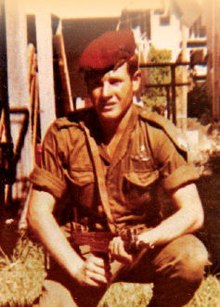


In memory of Corporal Moshe Yitzhak Tuval
Born in Rehovot 19th of Heshvan, 5712 (November 7, 1952). Fell in Egypt, 10th of Tishrei, 5734 (October 6, 1973)
Moshe Yitzhak Tuval was among the first in Bnei Brak to join the ultra-Orthodox Nahal unit. The rare combination of worlds is described from the point of view of Moshe Yitzhak's little sister, who was left with his memory after her brother fell in the Yom Kippur War.
Moshe Yitzhak Tuval was son to Malka and Eliyahu and older brother to Motti and Tsipora. He attended Talmud Torah in Rehovot and Bnei Brak and continued his studies in a yeshiva for youth in Ramot Remez in Haifa. He was so tall that they had to have a carpenter alter his bed there.
Moshe was a gifted soccer player. He avidly read the sports page and dreamed of traveling to England to learn soccer professionally.
 Moshe Yitzhak Tuval Z"l |
In 1971, he joined the IDF and was initially part of the ultra-Orthodox Nahal unit. That framework was started in the 60s for members of the ultra-Orthodox community who decide to join the army. When he returned from the army, he would put his younger sister Tsipora on his shoulders and sing her “The Queen of the Hermon”. Moshe was a cantor and was known as an excellent shofar blower. On Rosh Hashana in 1973 he returned home to blow the shofar at the synagogue. Immediately after the holiday, his brother Motti accompanied Moshe to the bus, on his way back to the base.
Prior to Yom Kippur, all of the religious solders gathered at the southern Mezah outpost in order to have a minyan for prayer services. On Yom Kippur, the day the war started, the Mezah outpost had 42 soldiers. A few hours after the attack began, an Egyptian grenade landed into his position, and Moshe Yitzhak threw himself on it. The commander, Shlomo Ardinest, described this act of bravery: “Since the position did not fall, the outcome was that he apparently saved everyone in the outpost. If he had not done what he did, no one in the outpost would have had a chance of surviving.”
Six hours later, with the fighting continuing at full intensity, Moshe Yitzhak died of his wounds. Several hours earlier, he had led the Musaf prayer service, his last prayer service before returning his soul to God on Yom Kippur.
His body was left behind, in the hands of the enemy. Only six years later, in 1979, with the start of peace negotiations between Israel and Egypt, were the bodies of the five casualties from the Mezah outpost returned and Tuval was buried in Kiryat Shaul. His parents were awarded the Chief of Staff citation on his behalf by Chief of the General Staff Mordecai (Motta) Gur. The citation read as follows:
“…From this position, Corporal Moshe Yitzhak Tuval z”l and three other soldiers fought at close range with light weapons and grenades against Egyptian commandos who outnumbered them manyfold. During the fighting, one of the soldiers shouted that a grenade had been thrown at the position. Three of the solders jumped out and were unhurt. Corporal Moshe Yitzhak Tuval z”l, who was busy firing at the enemy, bent down toward the grenade. At that moment, it exploded and Corporal Moshe Yitzhak Tuval z”l was fatally wounded. In his actions, Corporal Moshe Yitzhak Tuval z”l showed bravery, altruism and comradery.”
Thoughts from the Plonter Studio who created the film
We started work on the project with a feeling of great responsibility, which was combined with a bit of concern as well. As young and secular artists, we were worried that we would not be able to get into Moshe’s world, one that is complex and so different from our own. How do we convey the delicate relations within a world that we aren’t familiar with without missing his real story and its uniqueness?
In the clip, we connected between the two worlds—the material and the spiritual, the holy and the secular, the world on earth and the world in heaven. We felt that this is the best way to present all aspects of Moshe. In this way, we can show the complexity in his life: on the one hand, he was an ultra-Orthodox resident of Bnei Brak who studied in a yeshiva; on the other hand, he was a soccer lover who played with kids in the neighborhood and listened to the Beatles. On Rosh Hashana he blew the shofar in the synagogue in Bnei Brak and on Yom Kippur he fought the Egyptians.
In order to present Moshe’s world, we decided to use the white and warm colors that represent the spirit, the holiday and holiness. On the other hand, we used free and flowing contour lines that represent the material world and life. Moshe’s colors—his green uniform and his red beret—were unusual and very noticeable in his landscape, in the same way that he stood out. The clip gradually shifts from a rich and detailed world in the streets of Bnei Brak to an abstract, clean and minimalist world above the clouds.
We chose to tell the story through the eyes of Tsipora, his younger sister, who shared the memories of her big brother simply, accurately and with great emotion—little memories which reflect Moshe’s personality and the strong bond she had with him. The work on the project was very moving from our perspective and we are pleased and proud that we were given the opportunity to tell the story of Moshe Yitzhak Tuval.